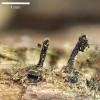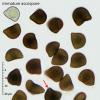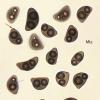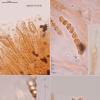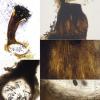
15-12-2025 15:48
 Danny Newman
Danny Newman
Melanospora cf. lagenaria on old, rotting, fallen

15-12-2025 15:54
 Johan Boonefaes
Johan Boonefaes
Unknown anamorph found on the ground in coastal sa

15-12-2025 21:11
 Hardware Tony
Hardware Tony
Small clavate hairs, negative croziers and IKI bb

15-12-2025 07:09
 Danny Newman
Danny Newman
indet. Rutstroemiaceae sp. on unk. fallen leavesMc

15-12-2025 07:05
 Danny Newman
Danny Newman
Pseudosclerococcum golindoi (det: Zotto)near Cosb

15-12-2025 11:49
 Danny Newman
Danny Newman
ITS sequences from the following two collections B

15-12-2025 12:34
 Danny Newman
Danny Newman
indet. Rhytismataceae on oak leafnear Purchase Roa

09-12-2025 12:06
 Andgelo Mombert
Andgelo Mombert
Bonjour,Je recherche l'article concernant Hypobryo
Enigmatic pyrenomycete
Enrique Rubio,
01-01-2025 13:45
THE ASCI ARE CYLINDRICAL, WITH A DOUBTFUL OR INCONSPICUOUS APICAL APPARATUS MLZ. NEGATIVE AND THEY HAVE EIGHT OBLIQUELY UNISERIATE ASCOSPORES. THE PARAPHYSES ARE ABUNDANT, IN SOME CASES WITH MONILIFORM SEGMENTS AND THEY EXCEED THE LEVEL OF THE ASCI.
THE MATURE ASCOSPORES ARE BLACISH BROWN, THEY HAVE AT LEAST ONE GERM PORE (RED ARROW), SOMETIMES TRANSVERSE SEPTA, A COMPLEX SYMMETRIY AND PERHAPS A SHORT GERM-SLIT ONLY WELL VISIBLE IN MELZER'S REAGENT (BLUE ARROW).
I CANNOT FIND AN APPROPRIATE GENUS FOR THIS FUNGUS, NOT EVEN WITHIN THE MELANOSPORALES, SO I AM ASKING FOR SOME CLUE TO SOLVE THIS ENIGMA.
I WOULD LIKE TO TAKE THIS OPPORTUNITY TO WISH YOU A HAPPY NEW YEAR.
Alain GARDIENNET,
03-01-2025 08:17
Re : Enigmatic pyrenomycete
Hi Enrique,
Your fungus should not be too far from Bellojisia rhynchostoma.
Happy new year for you, and forum !
Alain
Your fungus should not be too far from Bellojisia rhynchostoma.
Happy new year for you, and forum !
Alain
Thorben Hülsewig,
03-01-2025 10:48
Re : Enigmatic pyrenomycete
Hi Enrique,
Perhaps you have found Corylomyces selenospora.
best regards,
Thorben
Perhaps you have found Corylomyces selenospora.
best regards,
Thorben
Enrique Rubio,
03-01-2025 12:45
Re : Enigmatic pyrenomycete
Some colleagues had initially pointed me towards Corylomyces and later towards Bellojisia. I think this fungus could belong to the latter genus, because by the morphology of the ascomata, the asci with an inconspicuous apical apparatus and the presence of abundant paraphyses. But the spores are quite different from those of J. rynchospora. Unfortunately there is too little material to attempt a culture and sequencing, but I am very grateful for your help.
